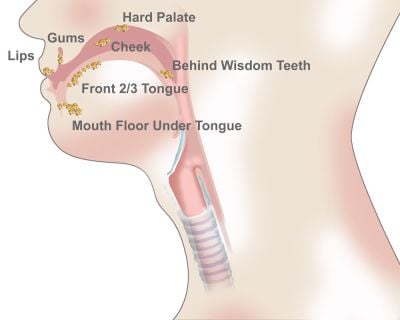Lip & Oral Cancer
Lip and oral cavity cancer is a type of head and neck cancer. Men in the United States are diagnosed with this type of cancer about 2.3 times more often than women. Lip and oral cancer can form in several different areas including the tissues of the lips, oral cavity (the mouth) or the oropharynx (the part of the throat at the back of the mouth).

The oral cavity includes the following:
- Lips
- Teeth
- Hard palate (the roof of the mouth)
- Soft palate and (the muscle back portion of the roof of the mouth)
- Retromolar trigone (the small area behind the wisdom teeth)
- Front two-thirds of the tongue
- Gingiva (gums)
- Uvula (the fleshy extension off of the soft palate that hangs above the throat)
- Tonsils
- Buccal mucosa (the lining of the inside of the cheeks and lips)
- Floor (bottom) of the mouth under the tongue
- Salivary glands (glands that make saliva)
Risk Factors for Lip & Oral Cancers
Tobacco and alcohol use are the two main factors that seem to affect the risk of developing lip and oral cavity cancer. Most patients diagnosed with this disease are over 60 years old. Always consult your doctor if you think you may be at risk for cancer.
Risk factors for lip and oral cavity cancer include the following:
- Using tobacco products of any type
- Heavy alcohol use
- For women: having more than three drinks on any day or more than seven drinks per week
- For men: have more than four drinks on any day or more than 14 drink per week
- Overexposure to natural sunlight or artificial sunlight (such as from tanning beds) without UV protection
- Being male
- Being infected with human papillomavirus (HPV)
If you have risk factors it does not mean that you will definitely develop cancer. And at the same time, having no risk factors present is not a guarantee that you won't develop a type of lip or oral cancer. That’s why it’s important to know how to spot signs and symptoms.
Signs and Symptoms of Lip & Oral Cancers
Many of the following symptoms are not from oral cancer. However, if you have any of the listed symptoms, you should contact your physician or dentist so they can diagnose and treat the areas of concern as soon as possible.
Symptoms of oral cancer include:
- Sores in the mouth or on the lips that will not heal.
- Lumps or thickening on the lips, gums, or in the mouth.
- Red or white patches on the gums, tongue, or lining of the mouth that do not heal.
- White patches are the most common and can become cancerous.
- Mixed red and white patches are more likely than white patches to develop into cancer.
- Bleeding in the mouth or lips.
- Numbness of the lower lip and chin.
- An unexpected change in voice.
- Loose teeth.
- Changes in mouth shape that affect dentures or mouthguards being able to fit properly in the mouth.
- Unexplained difficulty or pain when chewing, swallowing or moving the tongue or jaw.
- Swelling of the jaw.
- An unexplained sore throat or feeling that something is caught in the throat that won't go away.
- Lump in your neck.
- An earache that will not go away.
Visit the National Cancer Institute where this information and more can be found about Lip and Oral Cancer or ask your cancer care team questions about your individual situation.
Lo que usted necesita saber sobre el cáncer del del labio y la cavidad oral.

